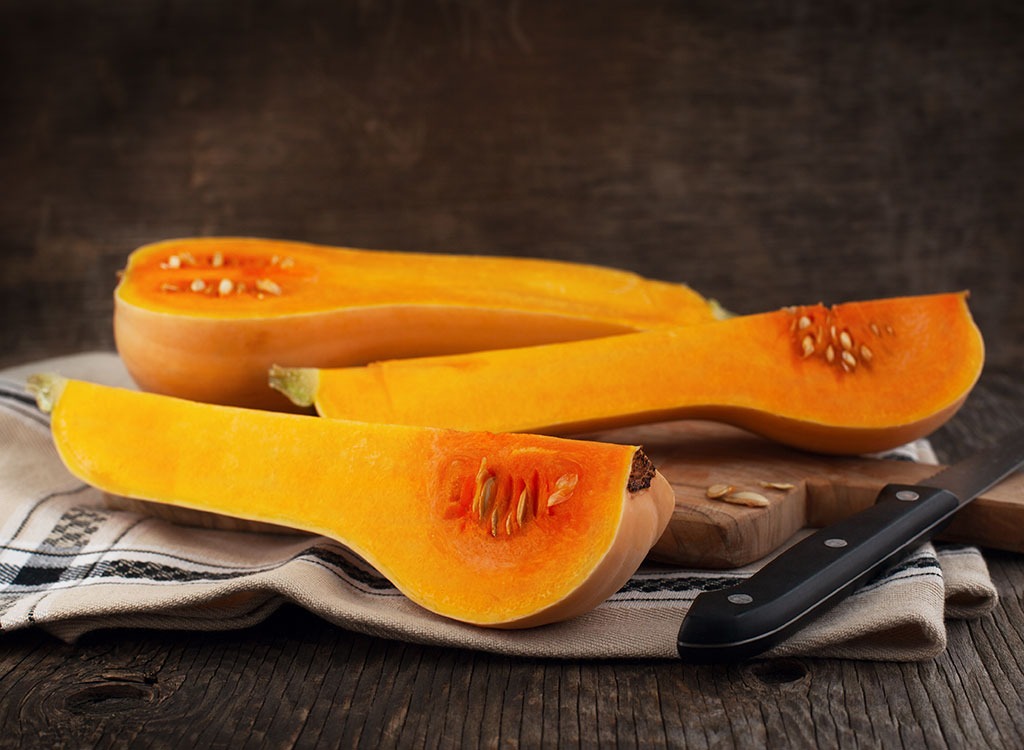The 20 Best Calcium-Rich Foods That Aren’t Dairy

It’s not exactly groundbreaking news that calcium plays a leading role in bone health and the prevention of both osteoporosis and cancer, but what you may not know is that there are ways to get the nutrient without downing dairy or taking a supplement. It’s best to consume vitamins and minerals naturally through food or drink, and these calcium-rich foods prove you don’t need dairy to get your daily fill.
For context, the average adult needs about 1,000 milligrams of calcium every day, and we found the most creative foods to get more calcium into your day. Stock up on these dairy-free foods the next time you’re at the grocery store, and you’ll be meeting that daily recommended number in no time.
Ranked in order from the least nutrient-dense to the most potent, we’ve found 20 non-dairy calcium foods that are easy to add to your diet. We used the USDA Food Composition Database to find how much calcium is present in each food.
Sunflower Seeds

Calcium content: 1 oz (28.3 g), 22 mg, 2.2% DV
Top salads with these seeds for some added crunch, or munch on a one-ounce serving as a snack. In addition to their calcium content, these tiny seeds are also a good source of antioxidant-rich vitamin E and copper—a nutrient that supports white blood cell health. It’s no wonder we named sunflower seeds one of the best snacks with 50 calories or less!
Sweet Potatoes

Calcium content: 1, (5 inches long) sweet potato, 39 mg, 3.9% DV
This humble root vegetable is a good source of calcium, potassium, and vitamins A and C. That’s a serious lineup for such a simple spud. Instead of baking one in the oven, why not tap into your culinary creativity and use the spuds to make some homemade fries? (Who doesn’t love fries?!) After slicing the potato lengthwise into strips, top with coconut oil, salt, pepper, and garlic powder, and pop them into the oven on 350 degrees until they’re crispy.
Baby Carrots

Calcium content: 15 medium, 50 mg, 5.0% DV
Think of carrots as orange wonder wands—their stellar calorie-to-fiber ratio keeps your belly flat, their calcium helps keep your bones strong, and their vitamin A content reduces the development of skin cancer cells. Pack some in a baggy and enjoy with an ounce of almonds as a mid-afternoon snack, or roast some in the oven with some rosemary, olive oil, and black pepper for a dinnertime side dish. The more veggie-packed recipe ideas you can whip up, the better off you are!
Figs

Calcium content: 1/4 cup (3-5 dried figs), 53 mg, 5.3% DV
While figs may be best known for their inclusion in the famous Fig Newton cookies, you’ll have to eat the whole fruit to reap its bone-building benefits. Chop up fresh or dried figs and add them to oatmeal, salads, or Greek yogurt with some honey, cinnamon, and slivered almonds. Alternatively, you can eat them whole as a quick, on-the-go snack. Three of them will cost you 110 calories.
Green Beans

Calcium content: 1 cup (cooked), 60 mg, 6.0% DV
Aside from its little-known calcium content, a cup of green beans packs 16 percent of the day’s vitamin C intake and 4 grams of fiber, which is one of the best nutrients for weight loss on the planet. Top steamed green beans with some olive oil, pine nuts, ground pepper, and garlic powder to tantalize your taste buds and reap the health-boosting benefits.
Broccoli

Calcium content: 1 cup (cooked), 62 mg, 6.2% DV
It seems mom was onto something when she told you how important it was to eat your broccoli. This cruciferous vegetable is rich in calcium and a host of other good-for-you nutrients like vitamins A, C, and B6.
Oranges

Calcium content: 1 large, 74 mg, 7.4% DV
While this citrus fruit is best known for its rich vitamin C content, one large orange also provides 74 milligrams of calcium. Enjoy the fruit solo as a snack, or pair some slices with spinach, slivered almonds, grilled chicken, shallots, and a ginger dressing to create an Asian-style salad.
Almonds

Calcium content: 1 oz, 23 nuts, 76 mg, 7.6% DV
Research shows that eating almonds before heading to the gym can help the body burn more fat and carbs during workouts. The small but mighty nut is also a potent source of satiating protein and fiber and packed with monounsaturated fats that help lower bad cholesterol levels when eaten in moderation. Eat them solo as an easy on-the-go snack, or pair with some 80% cacao dark chocolate (we like Green & Black’s Organic 85% Cacao Bar) and berries as a not-so-sinful dessert. They also make a great addition to yogurt parfaits and overnight oats. Oh, and did we also mention they’re some of the best calcium rich foods?
Clams

Calcium content: 3 oz (about 10 small), 78 mg, 7.8% DV
Work toward your daily calcium needs (while getting in a hefty dose of low-fat protein) with the help of clams.
Butternut Squash

Calcium content: 1 cup (205 g cooked), 84 mg, 8.4% DV
Butternut squash is not only packed with calcium and bloat-banishing potassium, but it’s also rich in carotenoids that fight heart disease, asthma, and arthritis and promotes healthy vision. Basically, it has it all—so eat it! We like to roast cubes of it in the oven with olive oil and spices. It also fairs well in soup recipes.
Sesame Seeds

Calcium content: 1 tablespoon, 88 mg, 8.8% DV
To reap the bone-healthy benefits of sesame seeds, take out your apron and spatula and whip up an Indian, Middle Eastern, or Japanese-inspired dish. Many popular vegetable, chicken, and noodle recipes within these cuisines use the ingredient.
Edamame

Calcium content: 1 cup, 98 mg, 9.8% DV
Anyone who has ever gone out for sushi has likely munched on the boiled soybean appetizer edamame. This dish is a good source of calcium, fiber, and muscle-building protein, in addition to calcium.
Broccoli Rabe

Calcium content: 1 NLEA serving (85 grams, steamed), 100 mg, 10% DV
About 85 grams of broccoli rabe steamed has a whopping 100 milligrams of bone-protecting calcium, and it’s a good source of immune-boosting vitamin C, too. Add the veggie to your diet to stay strong and healthy. We like to sauté it with olive oil and garlic and top it off with a dusting of Parmesan cheese.
Amaranth

Calcium content: 1 cup (cooked), 116 mg, 11.6% DV
If you haven’t heard of amaranth, it’s time to get familiar with it because it’s a high calcium food. One cup of this grain packs over 100 milligrams of the bone-supporting mineral. The grain is also rich in folate, a type of B-vitamin that helps to generate both healthy red and white blood cells in bone marrow and facilitate the conversion of carbohydrates into energy.
Navy Beans

Calcium content: 1 cup (cooked), 126 mg, 12.6% DV
White beans serve up not only a healthy dose of belly-filling fiber, muscle-building protein, and bloat-busting potassium, but also a significant dose of calcium. Need another reason to add some to your plate? It’s also rich in resistant starch, a nutrient that increases metabolism and helps promote fat oxidation and prevents long-term fat accumulation.
Kelp

Calcium content: 1 cup, 134 mg, 13.4% DV
Kelp, a variety of sea vegetable, is commonly found in Asian dishes. A cup of the greens serves up 134 milligrams of calcium, in addition to a hefty dose of fiber and iodine—a mineral that helps maintain thyroid health. If you like making homemade smoothies and juice, substitute kelp for kale to reap the benefits. Big fan of miso soup? Throw some kelp into the broth to up its nutritional value.
Chia Seeds

Calcium content: 1 oz, 179 mg, 17.9% DV
We all know chia seeds offer a generous amount of omega-3, but there doesn’t seem to be much hype about their calcium content. In just one ounce (a little more than 2 tablespoons), there are just about 180 milligrams of calcium, which is 18% of your recommended dietary allowance. Sprinkle a tablespoon or two into a bowl of oatmeal for an added boost of the mineral.
Cooked Greens

Calcium content: 1 cup, cooked 94 mg–268 mg, 9.4-26.8% DV
You likely already know that adding more greens to your plate is a healthy, low-calorie choice, but did you know that kale and collard greens can also help keep your bones strong? It’s true! To get the most of the mineral from these vegetables, you’ll want to consume them cooked—not raw for them to be considered high calcium foods. Take out your steamer or sauté up a batch with some seasoning for a quick side dish.
Sardines

Calcium content: 1 can (3.75 ounces), canned in oil with bones, 351 mg, 35.1% DV
Although sardines aren’t many people’s favorite fish, they’re one of the best sources of dairy-free calcium out there—if you can stomach them. Look for varieties canned with the bones, which are soft and completely edible. The bones are where all the calcium comes from. To make things more flavorful, toss the fish into a bed of leafy greens with tomato, cucumber, olives, feta, and red wine vinegar. The combo makes for a tasty, Mediterranean-inspired dish. For a quick snack, top whole-grain crackers with two or three sardines and a squeeze of fresh lemon for added flavor.
Tofu (with calcium sulfate)

Calcium content: 1/2 cup (prepared), 434 mg, 43.4%
Are you a big fan of edamame’s cousin, tofu? Although calcium content varies by brand, some varieties of tofu are some of the most potent calcium rich foods and serve up to 43 percent of the day’s calcium in a single 1/2-cup serving. Be sure to compare nutrition labels to ensure your go-to brand is a good pick for your bones.








